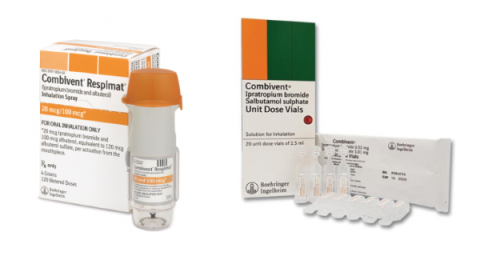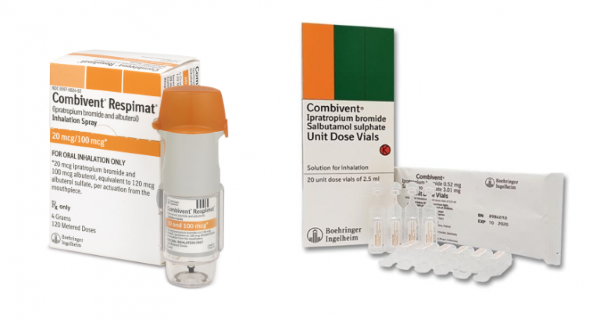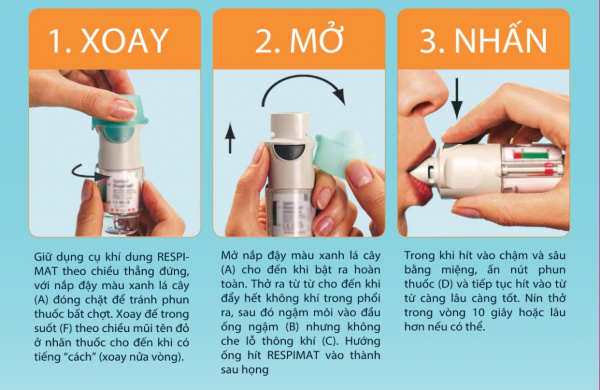Combivent®: How to use it and the notes you need to know

What is Combivent® (ipratropium, salbutamol) used for? Used in what disease? How to use it? What precautions should you take when using it? Let's find out with SignsSymptomsList through the article below!
Active ingredient names: ipratropium bromide monohydrate and salbutamol sulfate.
content
- 1. In what forms is Combivent® (ipratropium, salbutamol) used?
- 2. What is Combivent® (ipratropium, salbutamol) used for?
- 3. Dosage and how to use Combivent® (ipratropium, salbutamol) like?
- 4. When should Combivent® (ipratropium, salbutamol) not be used or be cautious of?
- 5. Possible side effects when taking Combivent® (ipratropium, salbutamol)
- 6. Some notes for pregnant and lactating women
- 7. Possible drug interactions when used with Combivent
- 8. What to do in case of an overdose of Combivent® (ipratropium, salbutamol)?
- 9. How should Combivent® (ipratropium, salbutamol) be stored?
1. In what forms is Combivent® (ipratropium, salbutamol) used?
Combivent® (ipratropium, salbutamol) is available in the following dosage forms:
- Combivent® Respimat® metered dose inhaler : Each inhalation unit contains 20 µg of ipratropium bromide and 100 µg of salbuterol.
- Combivent® UDVs® Single-dose ampoules : Each 2.5 ml dose unit contains 500 µg of ipratropium bromide and 2.5 mg of salbutamol.

Combivent® has 2 forms for you to choose from
2. What is Combivent® (ipratropium, salbutamol) used for?
The main active ingredients of the drug Combivent ® are ipratropium bromide monohydrate and salbutamol sulfate. Ipratropium bromide is a bronchodilator and bronchodilator. Salbutamol is a short-acting bronchodilator commonly used to treat asthma and chronic obstructive pulmonary disease (COPD).
Therefore, Combivent® (ipratropium, salbutamol) is effective in controlling bronchospasm in patients with chronic obstructive pulmonary disease (COPD) requiring regular treatment.
3. Dosage and how to use Combivent® (ipratropium, salbutamol) like?
Combivent® (ipratropium, salbutamol) has the following dosage forms and dosage instructions:
3.1. Combivent® Respimat® metered dose nebulizer inhaler (ipratropium, salbutamol):
- Dosage: Use an oral inhaler. 1 inhalation x 4 times/day each time. You can use more if necessary but note not to use more than 6 times / day.
- How to use: The medicine box includes 1 nebulizer and 1 aluminum medicine tube containing the active ingredient. The ampoules can be used 120 times, equivalent to 30 days of use.
To insert the tube into the nebulizer:
a. Depress the safety pin and remove the transparent base of the nebulizer.
b. Remove the ampoule from the box and insert the dropper tip into the applicator until it snaps into place.
c. Place the nebulizer on a flat surface with the cap facing up and press firmly so that the tube is fully inserted but the bottom of the tube is still exposed.
d. Replace the transparent base and leave it as it is until the medicine runs out or the medicine expires, then throw it all away.
Activation steps to prepare for the first use:
e. Then, hold the tool upright with the cap facing up.
f. Rotate the transparent base in the direction of the white arrow on the label until you hear a “click”.
g. Open the nebulizer cap.
H. Point the instrument toward the ground and press the pump button. Then close the lid.
i. Repeat steps e to h until the spray is visible, then repeat 3 more times before use.
Note: If not used for more than 3 days, the patient must activate the inhaler once before use. If not used for 21 days or more, the patient repeats steps e – i.
How to use an aerosol inhaler:
- Hold instrument upright, lid tightly closed.
- Rotate the transparent base in the direction of the arrow on the label until a “click”.
- Open the cover until it pops out completely.
- Breathe out slowly until all the air is out.
- Hold the tip of the tool firmly but do not cover the air vent.
- While inhaling slowly into the mouth, press the pump button and continue to inhale for as long as possible.
- Hold your breath for 10 seconds and then exhale slowly.
Details of how to use refer to the picture:

How to use Combivent®?
3.2. Combivent® UDVs® single-dose ampoules (ipratropium, salbutamol)
Always use Combivent® (ipratropium, salbutamol) as directed by your doctor or healthcare provider.
- Dosage:
Children over 12 years old, adults and the elderly: 1 single dose x 3 to 4 times per day.
- How to use:
- Prepare the nebulizer and follow the manufacturer's instructions. Consult your doctor if you do not know how to use it.
- Open the package and separate 1 single dose tube from the ampoule strip. Do not use if the tube is not tightly sealed or the solution inside has changed color.
- Hold the tube upright and screw the tip of the single dose tube open.
- Place all solution in the tube into the nebulizer chamber. If dilution is required, use sterile 0.9% NaCl solution.
- Then follow your doctor's instructions to use the nebulizer.
- After use, do not keep any remaining medicine in the machine.
- Clean the nebulizer according to the manufacturer's instructions.
4. When should Combivent® (ipratropium, salbutamol) not be used or be cautious of?
4.1. When not to use Combivent® (ipratropium, salbutamol)
Do not use Combivent® metered-dose nebulizer inhaler (ipratropium, salbutamol) if:
- Patients with obstructive hypertrophic cardiomyopathy or arrhythmia.
- Hypersensitivity to ipratropium bromide, salbutamol sulfate or atropine or its derivatives
4.2. Cases needing caution when using Combivent® (ipratropium, salbutamol)
Use caution when using Combivent® (ipratropium, salbutamol) in case of:
- Hypersensitivity reactions: urticaria, angioedema, rash, bronchospasm, anaphylaxis or oropharyngeal edema.
- Paradoxical bronchospasm: discontinue use immediately and treat with replacement therapy.
- Eye complications: blurred vision or visual disturbances occur when the spray gets into the eyes. Need to get to the nearest medical facility quickly.
- Patients with cardiovascular disease.
- Patients with narrow-angle glaucoma, prostatic hyperplasia or bladder neck obstruction, diabetes mellitus.
- Gastrointestinal motility disorders.
- Shortness of breath.
- Lactic acidosis.
- Patients with narrow-angle glaucoma, prostatic hyperplasia or bladder neck obstruction, diabetes mellitus.
5. Possible side effects when taking Combivent® (ipratropium, salbutamol)
Some common side effects when taking Combivent® (ipratropium, salbutamol) may be experienced such as:
- Upper respiratory tract infection.
- They, nasopharyngitis, bronchitis.
- Headache, difficulty breathing.
Rare side effects: Body dysfunction: immune system, metabolism and nutrition, nervous system, eyes, cardiovascular, respiratory, digestive, skin...

Using Combivent® incorrectly will lead to side effects of bronchitis, shortness of breath
6. Some notes for pregnant and lactating women
Several studies of ipratropium bromide in animals have shown no adverse effects on pregnancy. Salbutamol has been widely used for many years without noticeable effects during pregnancy. However, in animal studies there was evidence of some harmful effects on the fetus at very high doses.
Therefore, Combivent® (ipratropium, salbutamol) should not be used during pregnancy, especially the first trimester, and in nursing women unless the expected benefit is thought to outweigh any possible risks. out with infants.

Pregnant women should not use Combivent®
7. Possible drug interactions when used with Combivent
Combivent® (ipratropium, salbutamol) should not be used concurrently with the following drugs:
- Drugs acting on the adrenergic system.
- Xanthine derivatives.
- Corticosteroids.
- Monoamine oxidase (MAO) inhibitors or tricyclic antidepressants.
- Halogenated hydrocarbon anesthetic inhalers: halothane, trichlorethylene, and enflurane.
8. What to do in case of an overdose of Combivent® (ipratropium, salbutamol)?
Ipratropium bromide when taken in excess will cause acute effects such as dry mouth, visual disturbances. Manifestations of overdose with salbutamol include: tachycardia, angina, increased blood pressure, palpitations, tremor, hypokalemia, hypotension, cardiac arrhythmias and facial flushing.
To solve
Discontinue Combivent® (ipratropium, salbutamol) immediately and monitor blood acid and electrolyte levels.
9. How should Combivent® (ipratropium, salbutamol) be stored?
- Store in a place where the temperature is below 25°C. Not frozen .
- Avoid light.
- Do not use if solution is discolored.
Combivent® is a metered dose nebulizer and single dose inhaler. Combivent® contains the active ingredients ipratropium, salbutamol, which is used to treat chronic obstructive pulmonary disease (COPD). Besides Combivent®, there are other brand names that contain active ingredients with similar effects.
However, the use of the drug should be taken after consulting a doctor, pharmacist. You should see a Respiratory specialist to get the most appropriate advice.
Pregnancy is a time when it is important to ensure the safety of both mother and baby. Therefore, every operation needs to be done with care. However, during pregnancy it is inevitable that some medical treatment needs to be done. One of them requires an X-ray diagnosis. Are X-rays during pregnancy dangerous? Find out now: Are X-rays during pregnancy dangerous?